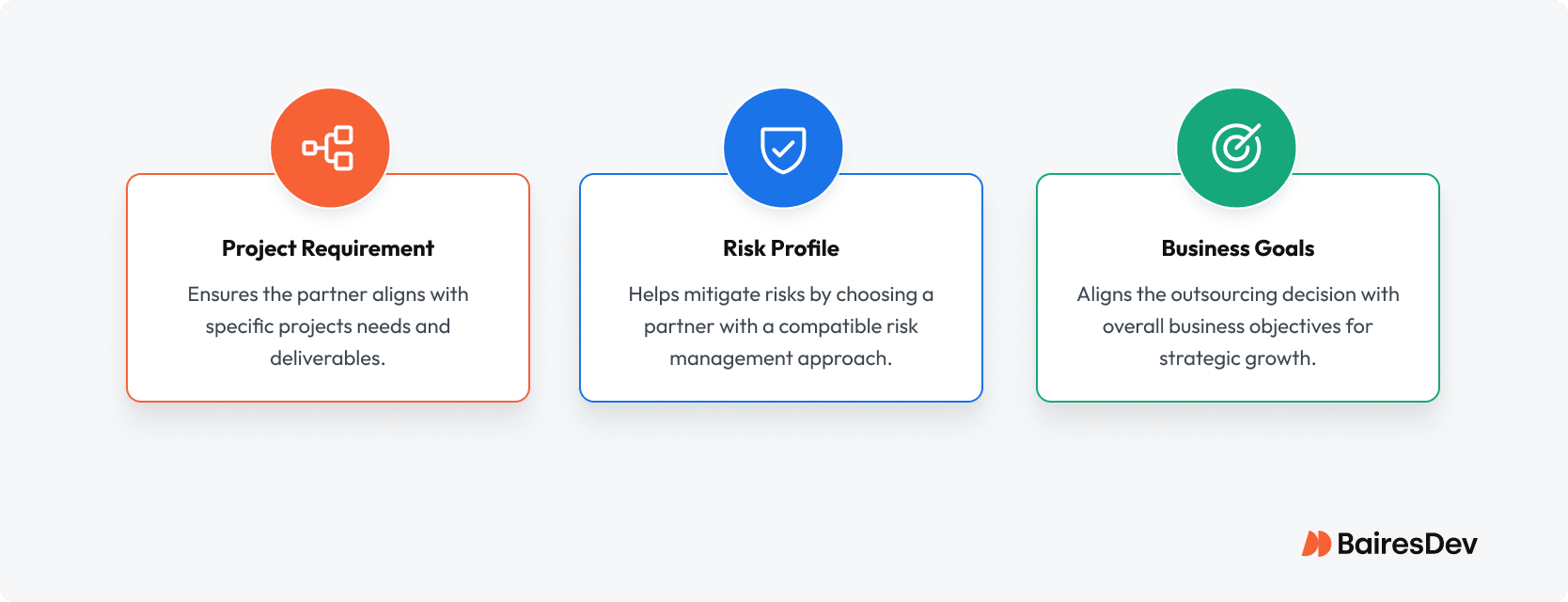Companies don’t win by working longer hours. They win by assembling the right mix of people who can move critical work forward. If your in-house team is overcommitted and the local market is slow, a well-run outsourced development approach can expand capacity, add specialized expertise, and keep your roadmap moving without dragging your leaders into more recruiting cycles.
Two market signals matter for planning. First, the global IT outsourcing market reached about $601B in 2024, with North America representing roughly one-third of demand. That scale means you can find experienced development teams that already know enterprise constraints. Second, average time to fill roles fell from 48 days in 2023 to 41 days in 2024, yet even 41 days is too long when a release date is on the line. Outsourcing covers the gap while you hire with care.
This guide is for the pragmatic technology leader who wants a reliable team, clear governance, and measurable outcomes. It focuses on the key factors that determine whether your outsourced development team becomes an extension of your existing team or a distraction.
Choose the Engagement Model That Fits Your Goals
Selecting an outsourcing partner starts with the model. Anchor the decision in your project requirements, risk profile, and business goals, not just rate cards.

Model 1: IT Staff Augmentation
What it is: Add specific talent to your existing team to cover shortfalls in capacity or skills.
When to use:
- You need a senior back-end engineer, a QA lead with regulated-industry experience, or a cloud security specialist—fast.
- You want to clear a feature backlog without shifting product ownership.
- You need to cover parental leave or attrition while recruiting runs.
Why it works:
- Fastest path to add capacity without changing your delivery model.
- External developers follow your process, use your tools, and join your ceremonies—so everyone stays aligned.
- You retain day-to-day direction and can scale your in-house development team up or down as demand changes.
How to manage:
- Assign a single internal point of contact (engineering manager or tech lead).
- Define “Done” clearly and post a shared board for priorities and blockers.
- Give newcomers access to build/test pipelines on day one.
- Avoid fragmented communication by routing guidance through one channel.
Model 2: Dedicated Team Model
What it is: Bring in a complete, dedicated software development team—engineers, QA, PM—that runs as an autonomous unit while integrating at agreed touchpoints.
When to use:
- You want a self-contained initiative delivered while your existing development team focuses on core business.
- Ideal for system migrations, new internal tools, or modular platform extensions.
- Useful for scale testing, performance work, or compliance-heavy streams.
Why it works:
- The external team owns a defined roadmap slice from discovery to release.
- Keeps internal teams focused on strategic priorities.
- Provides continuity for long-running, specialized work.
How to manage:
- Hold joint architecture reviews and align on technical standards.
- Run quarterly planning with both product and platform leads.
- Track delivery at a service-level view: milestones, quality gates, incident response.
Model 3: Project-Based Outsourcing
What it is: Contract an outsourcing partner for a fixed scope and outcome.
When to use:
- Proofs of concept, spike solutions, or automation packages.
- Discrete integrations, reports, or tooling you don’t want to own long-term.
Why it works:
- Clear acceptance criteria and quality gates keep governance light but effective.
- No long-term headcount commitment.
- Ideal for testing a vendor relationship before scaling.
How to manage:
- Define acceptance criteria, quality gates, and knowledge transfer up front.
- Run a small pilot to validate the right outsourced development team.
Across all three approaches, aim to turn variable, ambiguous work into a disciplined, measurable process that reduces surprises and protects your core business activities.
Build One Integrated Team—Not “Us and Them”
Outsourced development succeeds when external team members feel like part of the internal team. Treat them as an extension of your in-house software development capability.
Make Culture Explicit
Bring outsourced team members into sprint planning, backlog refinement, demos, and retros. Inclusive rituals are not niceties, as they reduce rework and raise accountability. Since the Covid-19 pandemic, distributed work has become the norm, not the edge case. A 2024 Stack Overflow survey reveals that 42% of developers reported hybrid work and 20% reported fully in-person arrangements, so cross-location collaboration patterns are familiar and productive when structured well.
Design Communication on Purpose
Replace ad-hoc pings with a predictable cadence. Use daily standups for flow, weekly syncs for priorities, and monthly or quarterly reviews for strategy. Centralize decisions and design artifacts. If your outsourced development partners cannot see user stories, feature specs, and incident history, they cannot make good decisions. Use one source of truth in your project management platform so everyone can track progress and understand trade-offs.
Clarify Roles and Pathways
Name a technical lead on your side who consolidates decisions and shields the team from context churn. Define who approves architecture changes, who triages incidents, and how to escalate scope changes. This keeps the entire team aligned and reduces cycle time.
Instrument the Work
Dashboards don’t replace management, but they eliminate guesswork. Track lead time for changes, deployment frequency, escaped defects, and burn-down trends. Share the data with both the in-house team and the external team to drive fact-based conversations.
Plan for Knowledge Flow
Require code-level documentation, runbooks, and architecture notes. Devoting a few hours per sprint to documentation avoids weeks of reverse-engineering later. Google Cloud’s 2023 DORA research emphasized the impact of quality documentation on performance and well-being, a reminder that documentation is part of throughput.
Nearshore, Offshore, or Both
Location strategy affects collaboration costs. Nearshore software development offers easier real-time overlap with US teams and cultural proximity, which lowers coordination tax for integrated team work. Offshore can stretch budgets further, but you will spend more energy on governance and handoffs.
Many enterprises now mix models. One 2023 Deloitte view shows offshore adoption in multi-function shared services rising from 13% in 2021 to 33% in 2023, a sign that leaders are optimizing footprint to balance cost and control.
GBS leaders also expect to keep growing capacity. Deloitte’s 2025 Global Business Services survey reveals that half of organizations planned to increase their footprint and many called out persistent skill set gaps as a driver. That aligns with what engineering leaders see when they try to hire for cloud, data, and security: strong talent is available, just not always in the ZIP code next to your HQ.
What You Gain When You Get It Right
Outsourcing is not about chasing lower rates. It is about delivering outcomes without overloading your internal resources.
Immediate Access to Specialized Expertise
You can mobilize a senior software development team that has solved your problem before. That speeds up solution selection, reduces risk, and avoids the “first time we hit this” tax. The global talent pool is broad and includes engineers who have shipped at scale in regulated sectors, which is hard to replicate with a local search.
Faster Time to Value
Because the recruitment process happens on your partner’s bench, you can start in weeks instead of months. Even though time to fill improved in 2024, it still averages more than a full sprint cycle. The right outsourced team mitigates that lag while you continue to hire for long-term roles.
Predictable Scaling
You can scale the entire team up or down without adding office space, equipment, or HR overhead. With the hybrid team model, capacity expands predictably while maintaining one playbook across environments and tools.
Reduced Operational Risk
A seasoned outsourcing company enforces secure access, environment isolation, and proven onboarding patterns. This lowers variance in quality and avoids single points of failure tied to a single hard-to-replace hire.
Governance That Keeps Work on Track
Whether you choose staff augmentation, a dedicated development team, or a fixed-scope project with an external agency, focus on governance that lets you see the work and steer it.
Set Crisp Goals
Define business goals, target users, and non-functional requirements early. Link the backlog to those targets so the outsourced development team understands why items matter. Tie sprint goals to the project’s success criteria.
Use a Shared Delivery System
Standardize on your project management and CI/CD flow. Grant access to repos, environments, and monitoring from day one. Keep discussion in shared channels so decisions don’t fragment across tools or email threads.
Run one operating cadence
- Daily: unblock flow and confirm priorities
- Weekly: adjust sprint scope and resource allocation
- Monthly: review metrics and risks with project managers and product leads
- Quarterly: recalibrate roadmap, budgets, and success metrics
Measure What Matters
Executives need a small set of indicators tied to outcomes. Start with lead time, deployment frequency, change failure rate, and time to restore. Add product KPIs such as activation, cycle time on top user journeys, and known-defect leakage. Use the data to guide decisions rather than to penalize a team for surfacing problems.
Protect IP and Data by Design
Implement NDAs and contracts that assign ownership of code and deliverables. Restrict access by role, log privileged actions, and keep sensitive configuration in managed secrets. Align the partner to your compliance controls from onboarding, not after a pen test.
Scale with Confidence
Pilots expose fit quickly. A good pattern is to begin with a focused outcome, then expand to a larger scope as trust builds.
- Prove the basics: Run a 6–10 week engagement that exercises collaboration and delivery: backlog alignment, hands-on code, test automation, and a small release to production or a staging environment with real users. Include knowledge transfer and an internal demo.
- Codify the playbook: If the pilot confirms fit, document the working model: branch strategy, review quality, Definition of Done, release calendar, and on-call expectations. Make it part of onboarding.
- Scale deliberately: Expand to a dedicated team once you are confident in velocity, quality, and communication. Use the same playbook and keep the integrated team structure. Many organizations find that a stable external team frees their internal team to focus on platform evolution, security, and core business priorities.
Cost, Yes. But Also Footprint and Flexibility
Rates vary by region, seniority, and scarcity of technical expertise. Don’t fixate on rate without including the total cost of time. If it takes two months to recruit and another month to onboard, you’ve lost a quarter—which is why many leaders now mix nearshore and offshore capacity.
Offshore can stretch budgets further, while nearshore supports real-time collaboration in US hours. In practice, a blended approach is common in large enterprises and has been rising in shared services models.
Practical Playbook for the First 30 Days
| Week 1 |
|
| Week 2 |
|
| Week 3 |
|
| Week 4 |
|
Final Perspective
Outsourcing services only pay off if the result feels like one cohesive team.
Treat your outsourced software development team as part of your organization: same tools, same standards, same rituals. Choose the dedicated team model when you need an full team to own a stream of work, use IT staff augmentation for targeted capacity, and pull in a project-based contract for discrete outcomes.
Put governance ahead of urgency, align the external team with your core business goals, and measure delivery with a few clear metrics. The companies that do this well extend their capacity without diluting their standards, and they keep shipping while competitors wait for paperwork.






